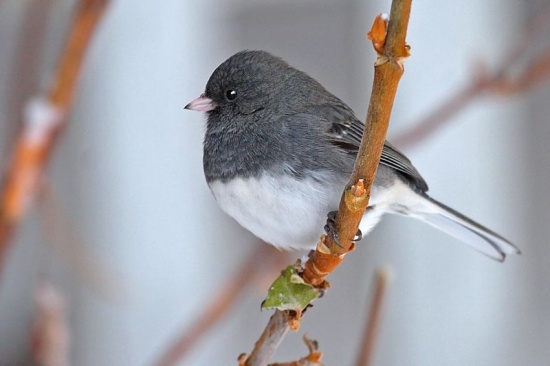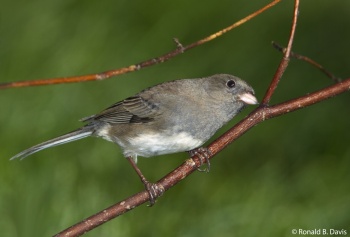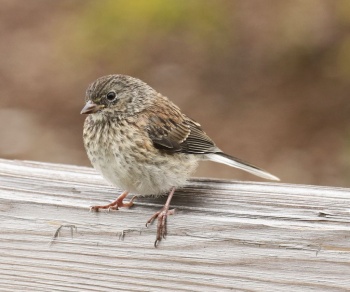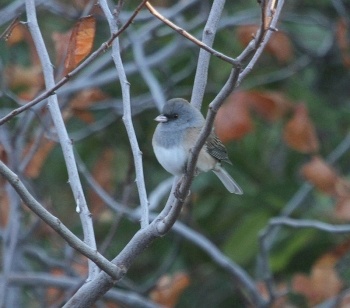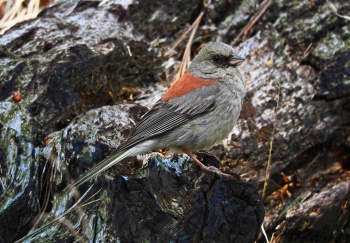(Genus links added) |
m (→Vocalisation) |
||
| (30 intermediate revisions by 9 users not shown) | |||
| Line 1: | Line 1: | ||
| + | [[Image:Dark-eyed_Junco.jpg|thumb|550px|right|Male, "Slate-colored" subspecies.<br />Photo © by {{user|Muskrat|Muskrat}}<br /> Northeastern [[Pennsylvania]], [[USA]], 25 January 2006]] | ||
;[[:Category:Junco|Junco]] hyemalis | ;[[:Category:Junco|Junco]] hyemalis | ||
| − | |||
| − | |||
| − | |||
==Identification== | ==Identification== | ||
| − | 5-6 1/4 in (13-16 cm) | + | [[Image:Slate-colored Junco female on a-l-d branch pre-edited 2 1215.jpg|thumb|350px|right|Female ''Slate-colored'' subspecies<br />Photo © by {{user|rdavis|Ronald B. Davis}}<br />Orono, [[Maine]], [[USA]], 28 October 2010]] |
| + | 5-6 1/4 in (13-16 cm)<br /> | ||
| + | This species shows much geographic variation in color, with many recognized populations or subspecies. All are easily recognizable as Juncos, due to the body shape and behavior. | ||
| − | + | The subspecies are named and grouped variously depending on the authority listing them, but the following four major designations are common: | |
| − | === | + | =====Oregon Junco===== |
| − | Found in western populations | + | Found in western populations. The male has a black hood, chestnut mantle, and white underparts with buff sides. The '''female''' has a gray hood. |
| − | + | =====Slate-colored Junco===== | |
| − | + | The male has a dark slate-gray head, upper breast, flanks, and upperparts, with a white lower breast and belly. Both forms have pink bill and dark gray tail with white outer tail feathers conspicuous in flight. | |
| − | + | =====White-winged Junco===== | |
| − | + | [[Image:Junco Dark-eyed juv 2019-05-22 078.jpg|thumb|350px|right|Juvenile<br />Photo © by {{user|ducbucln|ducbucln}}<br />Manzanita, [[Oregon]], [[USA]], 22 May 2019]] | |
| − | === | + | Isolated populations in the pine forests of the Black Hills in western [[South Dakota]] and eastern [[Montana]]. Two white wing bars, extensive white in outer tail feathers. |
| − | + | =====Gray-headed Junco===== | |
| − | |||
| − | |||
| − | + | Populations in the Southwest. Gray overall, with reddish-brown back. | |
| − | |||
| − | |||
| − | |||
| − | |||
| − | |||
| − | Populations in the Southwest | ||
| − | |||
| − | |||
| − | |||
| − | |||
==Distribution== | ==Distribution== | ||
| − | Northern birds migrate further south; many populations are permanent residents or altitudinal migrants. In winter, juncos are familiar in and around towns. The "Slate-coloured" Junco is a rare vagrant to western Europe and has wintered in Great Britain, usually in a domestic garden. | + | Northern birds migrate further south; many populations are permanent residents or altitudinal migrants. In winter, juncos are familiar in and around towns. The "Slate-coloured" Junco is a rare vagrant to western [[Europe]] and has wintered in [[Great Britain]], usually in a domestic garden. |
==Taxonomy== | ==Taxonomy== | ||
| − | The best-known species of junco, a genus of small American sparrows. | + | The best-known species of junco, a genus of small American sparrows. Until recently the many geographical forms of this bird were considered separate species, but since they interbreed wherever their ranges meet, they are now considered one species.<br/> |
| + | [[Guadalupe Junco]] was formerly included in this species. | ||
| + | ====Subspecies==== | ||
| + | [[Image:Junco Dark-eyed Pink-sided 2014-10-11 076a.jpg|thumb|350px|right|Subspecies mearnsi, Pink sided <br />Photo © by {{user|ducbucln|ducbucln}}<br />Kelseyville, California, October 2014 ]] | ||
| + | There are around 14-15 subspecies<sup>[[#References|[1]]]</sup><br /> | ||
| + | '''Slate-colored Group''' | ||
| + | *''J. h. hyemalis'': Northern [[Alaska]] and [[Yukon]] to north-central [[US]]; winters to northern [[Mexico]] | ||
| + | *''J. h. carolinensis'': Appalachian Mountains to northern [[Georgia]] | ||
| + | *''J. h. cismontanus'' ('''Cassiar'''): South-central Yukon to west-central [[Alberta]]; winters to northern Baja and central [[Texas]]<br /> | ||
| + | '''Oregon Group''' | ||
| + | *''J. h. oreganus'': Coastal south-eastern Alaska to central [[British Columbia]]; winters to central [[California]] | ||
| + | *''J. h. montanus'': Interior British Columbia and south-western Alberta to eastern [[Oregon]], western [[Montana]], central [[Idaho]] | ||
| + | *''J. h. shufeldti'': Western slopes of coastal mountains from south-western British Columbia to western Oregon | ||
| + | *''J. h. thurberi'': Southern Oregon to mountains of San Diego Co. and southern [[Nevada]]; winters to northern Baja, south-western [[New Mexico]] | ||
| + | *''J. h. pinosus'': Coastal ranges of [[California]] (San Francisco to southern Monterey Co.) | ||
| + | *''J. h. pontilus'': Mountains of northern [[Baja California]] (Sierra Juárez) | ||
| + | *''J. h. townsendi'': Mountains of northern Baja California (San Pedro Mártir) | ||
| + | '''Pink-sided Group''' | ||
| + | [[Image:Junco-composite MG 0077-post.jpg|thumb|350px|right|From left to right: Oregon female; Slate colored 1st winter male; Oregon male; Slate colored 1st winter; Oregon male; bird at front Oregon male) <br />Photo © by {{user|digishooter|digishooter}}<br />Wofford Heights, Kern County, [[California]], [[USA]], 20 December 2014]] | ||
| + | *''J. h. mearnsi'' South-eastern [[Alberta]], south-western [[Saskatchewan]] to eastern [[Idaho]], [[Montana]], north-eastern [[Wyoming]] | ||
| + | '''White-winged Group''' | ||
| + | *''J. h. aikeni'' : South-eastern Montana to western [[South Dakota]], north-eastern Wyoming and north-western [[Nebraska]] | ||
| + | '''Gray-headed Group''' | ||
| + | *''J. h. caniceps'': Mountains of southern Idaho to [[Utah]] and northern New Mexico; winters to north-western Mexico | ||
| + | '''Red-backed Group''' | ||
| + | *''J. h. dorsalis'': Mountains of New Mexico, northern Arizona and extreme western Texas | ||
| + | |||
==Habitat== | ==Habitat== | ||
Openings and edges of coniferous and mixed woods; in winter, fields, roadsides, parks, suburban gardens. | Openings and edges of coniferous and mixed woods; in winter, fields, roadsides, parks, suburban gardens. | ||
==Behaviour== | ==Behaviour== | ||
| − | This lively territorial bird is a ground dweller | + | ====Actions==== |
| + | [[Image:Junco-Dark-eyed- Red-backed -AZ-DSCN1393 copy 2-.jpg|thumb|350px|right|Red-backed Junco<br />Photo © by {{user|Brian+Hubbs|Brian Hubbs}}<br />Greer, [[Arizona]], 10 July 2016]] | ||
| + | This lively territorial bird is a ground dweller, but also moves through the lower branches of trees and seeks shelter in the tangle of shrubs. | ||
| + | ====Breeding==== | ||
| + | The 3-6 pale bluish or greenish eggs, with variegated blotches concentrated at the larger end, are laid in a deep, compact nest of rootlets, shreds of bark, twigs, and mosses, lined with grasses and hair, placed on or near the ground, protected by a rock ledge, a mud bank, tufts of weeds, or a fallen log. Incubation lasts about 12 days by the female only. Young juncos leave the nest from 10 to 13 days after hatching. These birds often have 2 to 3 broods a summer. | ||
| + | ====Diet==== | ||
| + | Feeds on seeds, small fruits, insects, and berries. | ||
| + | ====Vocalisation==== | ||
| + | '''Call''': A rapid ''tew tew tew''. Sometimes given softly. Also, ''tzeep tzeep'' especially when disturbed. <br /> | ||
| + | '''Song''': A high trill<br /> | ||
| + | <flashmp3>Dark-eyedJunco.mp3</flashmp3><br /> | ||
| + | ''[[Media:Dark-eyedJunco.mp3|Listen to a song clip (subspecies J. h. pinosus)]]''<br /> | ||
| + | Recording © by {{user|jmorlan|Joseph Morlan}}<br /> | ||
| + | Pacifica, [[California]], 22 March 2020 | ||
| + | |||
| + | ====Movements==== | ||
| + | Mostly migratory; males migrate earlier than females, and tend to winter farther north in the East. Some populations resident. | ||
| + | |||
| + | ==References== | ||
| + | #{{Ref-Clements6thAug19}}#Nolan Jr., V., E. D. Ketterson, D. A. Cristol, C. M. Rogers, E. D. Clotfelter, R. C. Titus, S. J. Schoech, and E. Snajdr (2020). Dark-eyed Junco (''Junco hyemalis''), version 1.0. In Birds of the World (A. F. Poole and F. B. Gill, Editors). Cornell Lab of Ornithology, Ithaca, NY, USA. https://doi.org/10.2173/bow.daejun.01 | ||
| + | {{ref}} | ||
| − | |||
| − | |||
| − | |||
| − | |||
| − | |||
| − | |||
| − | |||
| − | |||
| − | |||
==External Links== | ==External Links== | ||
| − | {{GSearch|Junco+hyemalis}} | + | {{GSearch|Junco+hyemalis}} |
| − | [[Category:Birds]] [[Category:Junco]] | + | <br /> |
| + | {{Video|Dark-eyed_Junco}} | ||
| + | |||
| + | [[Category:Birds]] [[Category:Junco]] [[Category:Videos]] | ||
Revision as of 07:13, 25 March 2020
- Junco hyemalis
Identification
5-6 1/4 in (13-16 cm)
This species shows much geographic variation in color, with many recognized populations or subspecies. All are easily recognizable as Juncos, due to the body shape and behavior.
The subspecies are named and grouped variously depending on the authority listing them, but the following four major designations are common:
Oregon Junco
Found in western populations. The male has a black hood, chestnut mantle, and white underparts with buff sides. The female has a gray hood.
Slate-colored Junco
The male has a dark slate-gray head, upper breast, flanks, and upperparts, with a white lower breast and belly. Both forms have pink bill and dark gray tail with white outer tail feathers conspicuous in flight.
White-winged Junco
Isolated populations in the pine forests of the Black Hills in western South Dakota and eastern Montana. Two white wing bars, extensive white in outer tail feathers.
Gray-headed Junco
Populations in the Southwest. Gray overall, with reddish-brown back.
Distribution
Northern birds migrate further south; many populations are permanent residents or altitudinal migrants. In winter, juncos are familiar in and around towns. The "Slate-coloured" Junco is a rare vagrant to western Europe and has wintered in Great Britain, usually in a domestic garden.
Taxonomy
The best-known species of junco, a genus of small American sparrows. Until recently the many geographical forms of this bird were considered separate species, but since they interbreed wherever their ranges meet, they are now considered one species.
Guadalupe Junco was formerly included in this species.
Subspecies
There are around 14-15 subspecies[1]
Slate-colored Group
- J. h. hyemalis: Northern Alaska and Yukon to north-central US; winters to northern Mexico
- J. h. carolinensis: Appalachian Mountains to northern Georgia
- J. h. cismontanus (Cassiar): South-central Yukon to west-central Alberta; winters to northern Baja and central Texas
Oregon Group
- J. h. oreganus: Coastal south-eastern Alaska to central British Columbia; winters to central California
- J. h. montanus: Interior British Columbia and south-western Alberta to eastern Oregon, western Montana, central Idaho
- J. h. shufeldti: Western slopes of coastal mountains from south-western British Columbia to western Oregon
- J. h. thurberi: Southern Oregon to mountains of San Diego Co. and southern Nevada; winters to northern Baja, south-western New Mexico
- J. h. pinosus: Coastal ranges of California (San Francisco to southern Monterey Co.)
- J. h. pontilus: Mountains of northern Baja California (Sierra Juárez)
- J. h. townsendi: Mountains of northern Baja California (San Pedro Mártir)
Pink-sided Group
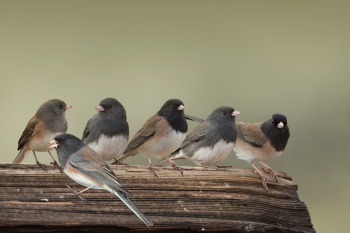
Photo © by digishooter
Wofford Heights, Kern County, California, USA, 20 December 2014
- J. h. mearnsi South-eastern Alberta, south-western Saskatchewan to eastern Idaho, Montana, north-eastern Wyoming
White-winged Group
- J. h. aikeni : South-eastern Montana to western South Dakota, north-eastern Wyoming and north-western Nebraska
Gray-headed Group
- J. h. caniceps: Mountains of southern Idaho to Utah and northern New Mexico; winters to north-western Mexico
Red-backed Group
- J. h. dorsalis: Mountains of New Mexico, northern Arizona and extreme western Texas
Habitat
Openings and edges of coniferous and mixed woods; in winter, fields, roadsides, parks, suburban gardens.
Behaviour
Actions
This lively territorial bird is a ground dweller, but also moves through the lower branches of trees and seeks shelter in the tangle of shrubs.
Breeding
The 3-6 pale bluish or greenish eggs, with variegated blotches concentrated at the larger end, are laid in a deep, compact nest of rootlets, shreds of bark, twigs, and mosses, lined with grasses and hair, placed on or near the ground, protected by a rock ledge, a mud bank, tufts of weeds, or a fallen log. Incubation lasts about 12 days by the female only. Young juncos leave the nest from 10 to 13 days after hatching. These birds often have 2 to 3 broods a summer.
Diet
Feeds on seeds, small fruits, insects, and berries.
Vocalisation
Call: A rapid tew tew tew. Sometimes given softly. Also, tzeep tzeep especially when disturbed.
Song: A high trill
<flashmp3>Dark-eyedJunco.mp3</flashmp3>
Listen to a song clip (subspecies J. h. pinosus)
Recording © by Joseph Morlan
Pacifica, California, 22 March 2020
Movements
Mostly migratory; males migrate earlier than females, and tend to winter farther north in the East. Some populations resident.
References
- Clements, J. F., T. S. Schulenberg, M. J. Iliff, S. M. Billerman, T. A. Fredericks, B. L. Sullivan, and C. L. Wood. 2019. The eBird/Clements Checklist of Birds of the World: v2019. Downloaded from http://www.birds.cornell.edu/clementschecklist/download/
- Nolan Jr., V., E. D. Ketterson, D. A. Cristol, C. M. Rogers, E. D. Clotfelter, R. C. Titus, S. J. Schoech, and E. Snajdr (2020). Dark-eyed Junco (Junco hyemalis), version 1.0. In Birds of the World (A. F. Poole and F. B. Gill, Editors). Cornell Lab of Ornithology, Ithaca, NY, USA. https://doi.org/10.2173/bow.daejun.01
Recommended Citation
- BirdForum Opus contributors. (2024) Dark-eyed Junco. In: BirdForum, the forum for wild birds and birding. Retrieved 23 April 2024 from https://www.birdforum.net/opus/Dark-eyed_Junco
External Links




